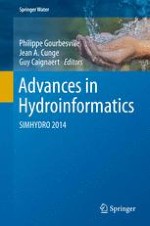2016 | OriginalPaper | Buchkapitel
Calibration of an Air Entrainment Model for CFD Spillway Applications
verfasst von : Daniel Valero, Rafael García-Bartual
Erschienen in: Advances in Hydroinformatics
Verlag: Springer Singapore
Aktivieren Sie unsere intelligente Suche, um passende Fachinhalte oder Patente zu finden.
Wählen Sie Textabschnitte aus um mit Künstlicher Intelligenz passenden Patente zu finden. powered by
Markieren Sie Textabschnitte, um KI-gestützt weitere passende Inhalte zu finden. powered by
